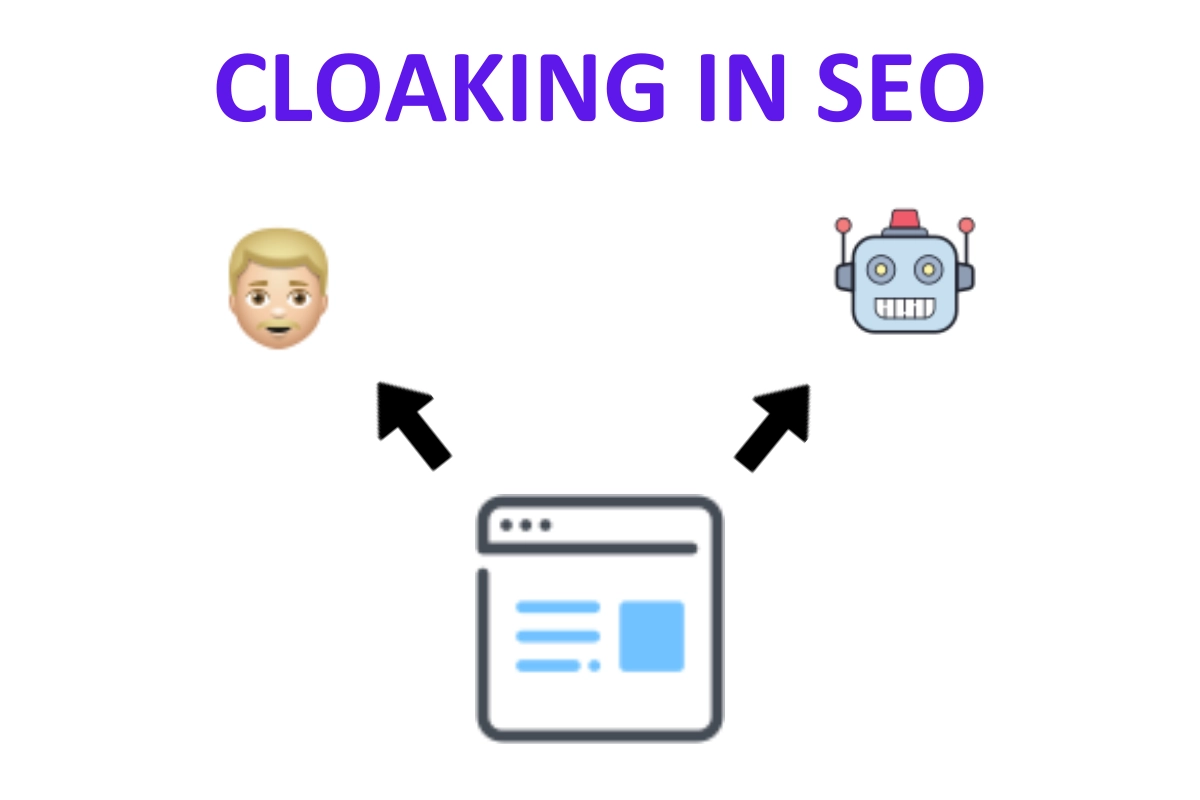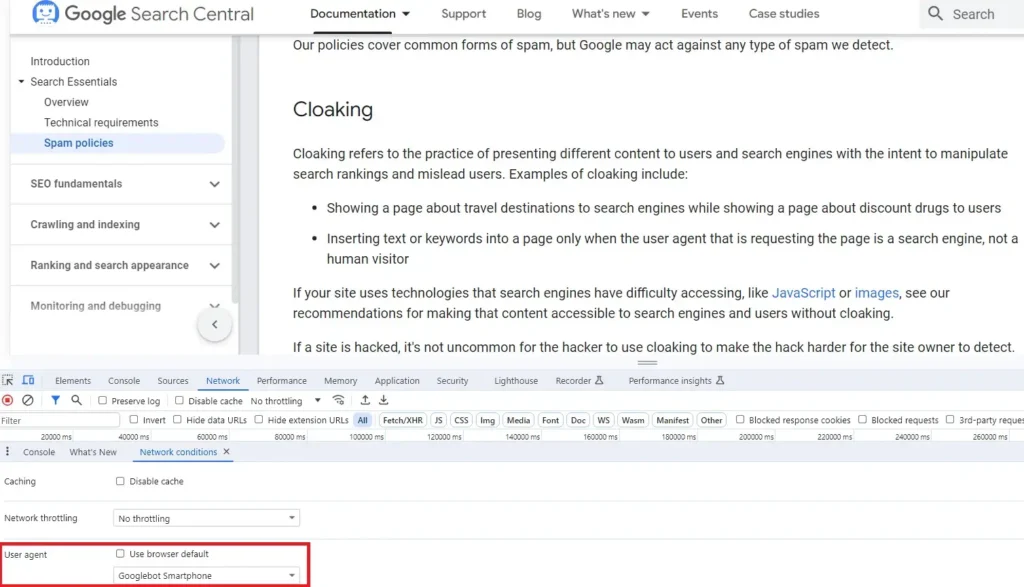SEO Cloaking: The Definitive Guide

SEO Cloaking is a practice used by webmasters to present different content or URLs to search engines than they display to regular users.
It is considered a violation of many search engines’ guidelines and can result in penalization if detected.
In this article, we will discuss what is SEO Cloaking, how and why it’s done, and the potential risks associated with it.
We’ll also discuss the types of cloaking methods and how to avoid SEO Cloaking penalties.
Table of Contents
What Is SEO Cloaking?
SEO Cloaking is a deceptive technique employed within the realm of Search Engine Optimization (SEO).
Essentially, this method involves presenting different content to search engine bots than what is displayed to human users.
The goal is to trick search engines into assigning a higher ranking to a page than it might actually deserve.
This is achieved by feeding the bots with content full of targeted SEO keywords while showing entirely different, often more user-friendly content to human visitors.
This practice is highly discouraged by search engines, and websites found to be indulging in cloaking can face hefty penalties, including de-indexing.
Therefore it is considered a main technical SEO issue that should be avoided at all costs.
Types of Cloaking Methods
User-agent Cloaking
User-agent cloaking involves sending a different content or URL to the search engine depending on the user’s browser.
IP Address Cloaking
IP address cloaking involves sending a different content or URL to the search engine based on the user’s IP address.
JavaScript Cloaking
JavaScript cloaking involves using JavaScript to show different content to search engine bots and human visitors.
Hidden Text Cloaking
Another way to cloak is by hiding text using CSS or other techniques, making it invisible to human users but still readable by search engine bots.
HTTP Header Cloaking
HTTP header cloaking involves manipulating HTTP headers to show different content to search engine bots and human visitors.
Want More Traffic?
How is Cloaking Technically Done in SEO?
#1 Cloaking Example: Adding a code
Cloaking in SEO is executed using various SEO coding techniques. Here is an example of a PHP code snippet that performs user-agent cloaking:
“`php
<?PHP
$userAgent = strtolower($_SERVER[‘HTTP_USER_AGENT’]);PHP
if (strpos($userAgent, ‘google’) !== false) {
// If the user agent is a Google bot
echo ‘Hello, Google bot. Here is some keyword-stuffed content.’;
} else {
// If the user agent is anything else
echo ‘Welcome, human! Enjoy our user-friendly content.’;
}
?>
“`
In this code, if the user agent is recognized as a Google bot, the site displays SEO-focused content. For all other user agents, presumably human users, the site shows more user-friendly content.
Note that this is a simplified example, and real-world cloaking methods could be more complex and subtle.
As mentioned earlier, cloaking is a violation of most search engines’ policies and can result in penalties.
#2 Cloaking Example: Using a Redirect Script
Another method of cloaking in SEO involves the use of redirect scripts. Here’s an example using JavaScript:
“`javascript
<script type=”text/javascript”>
var useragent = navigator.userAgent;
if (useragent.match(/Googlebot/i)) {
location.replace(“bot_page.html”);
} else {
location.replace(“user_page.html”);
}
</script>
“`
In this script, the browser’s user agent string is examined. If the user agent string matches ‘Googlebot’, the script redirects to ‘bot_page.html’ which could be a page optimized for SEO.
For all other user agents, which are presumably human users, the script redirects to ‘user_page.html’, a page designed for a better user experience.
#3 Cloaking Example: Writing Incorrect Title Tag, Description, and URL
Another tactic that involves misleading search engines is writing incorrect title tags, descriptions, and URLs.
This approach is designed to manipulate search engines into thinking the webpage contains different content than it really does.
For instance, a title tag may indicate that the page contains information about a popular topic to attract traffic, but the actual page content may be entirely different.
“`html
<head>
<title>Popular Topic A</title>
<meta name=”description” content=”In-depth information about Popular Topic A.”>
</head>
“`
In the above example, if the webpage does not contain in-depth information about ‘Popular Topic A’, this is a form of cloaking.
The same can be true if the URL suggests that the page is about one topic, whereas it is actually about something else.
Always ensure that your title tags, descriptions, and URLs accurately represent your page content.
#4 Cloaking Example: Hidden Text
Another common cloaking practice is using hidden text on a webpage. This involves adding text to the page that is not visible to human users but can be seen by search engine crawlers.
“`html
<p style=”display:none;”>Hidden Text</p>
“`
This tactic may involve using the same color for the text as the background of the page, making it invisible to human users, but still detectable by search engines.
This is done in an attempt to manipulate search engine rankings by including keywords or content that may not be directly relevant to the page’s visible content.
Hidden text is a violation of most search engine guidelines and can result in penalties, so it should always be avoided. Also, that’s a very not smart method that doesn’t work anyway (for at least 8 years or more).
Why Do People Use Cloaking for SEO?
The main reason is to improve their website’s visibility and rankings in search engines.
By showing different content to search engine bots, websites may be able to rank for keywords that they wouldn’t normally rank for with their actual content.
This way, they can appear higher in the rankings on a “white” keyword to send the user to a spammy or “grey area” related page.
For example, a website has a page that ranks #1 for “office tables” – a competitive keyword with a high search volume.
The website owner takes advantage of the high traffic the page revives and changes the content to be focused on another topic, “loans” for example, but keeps serving the original content to the search engine and maintaining the page’s ranking.
Through the high traffic that the page receives, there is a chance that one of the users is interested in loans and will find what he is looking for in the advertisement/landing page that will be shown to him, even though the topic he was looking for was “office tables“.
Through the “law of large numbers”, those who perform cloaking manage to profit from advertisements or purchases of users who have reached another website or page by holding on to the ranking of a page that should otherwise not appear in the search engine results.
Is Cloaking a Black Hat Technique?
Yes, cloaking is considered a Black Hat SEO technique. Black Hat SEO refers to practices that violate search engine guidelines and aim to increase a page’s ranking in search engine result pages (SERP) through deceptive methods.
It is therefore advisable to avoid such methods and focus on ethical, or White Hat SEO strategies for long-term, sustainable success in SERP rankings.
Risks of Cloaking
As mentioned SEO Cloaking is considered a violation of most search engines’ terms of service and as a result, can:
1. Result in a Penalty
Google and other search engines take cloaking very seriously and can issue penalties for websites that are caught doing it.
This can have a devastating effect on your website’s visibility and rankings, as well as its overall reputation.
2. Lead to Being Banned from Search Engines
Search engines can also take the drastic step of banning a website from their search index if it is found to be using SEO Cloaking.
This means that the website will no longer show up in search results which can lead to a huge loss of organic traffic.
3. Harm Your Reputation as an SEO/Digital Marketer
Using black hat techniques like cloaking can seriously harm your reputation as an SEO or digital marketer.
It goes against the principles of ethical and fair practices in the industry and can damage your credibility with clients and potential employers.
There are (even many) SEOs who still use this method but the risk is huge and manipulation isn’t the way to achieve rankings to traffic (like any other shortcut in life) as it inevitably leads to negative consequences.
A professional digital marketing agency should always follow ethical and compliant practices to ensure long-term success for their clients.
Is Headless CMS or SSR Based on Cloaking?
No, headless CMS or server-side rendering (SSR) does not use cloaking. These methods involve delivering the same content to both users and search engines, unlike cloaking which serves different content to each party.
Headless CMS and SSR are legitimate techniques used for improving website performance and user experience while cloaking is a deceptive tactic that violates search engine guidelines.
How to Avoid SEO Cloaking?
The best way to avoid SEO Cloaking is to make sure you are not doing anything that would be considered “unnatural” in the eyes of search engines. If you are unsure whether something could be considered cloaking or not, it is best to err on the side of caution and avoid it altogether.
Additionally, make sure you use Google Search Console to check all of your pages for any issues that could lead to a penalty or ban.
This way you can ensure that your website is in compliance with Google’s guidelines and will not be penalized for any violations.
Moreover, if you’re using the services of a third-party agency, a freelancer, or a developer with access to your site, make sure that they are aware of the risks associated with SEO Cloaking and that they won’t do anything to compromise your website.
Clocking is also common after your site gets hacked. Therefore, make sure to monitor your website for any signs of hacking and take appropriate steps to prevent it from happening like using security plugins and regularly updating your software.
SEO Cloaking Checker
The best way is to change the user-agent of your web browser to “Googlebot” so you can see if the site is doing anything different than it should.
For example, you can use the Google Chrome web developer tools (inspect elements) to view the source code of a page under the user agent of Googlebot.
This will allow you to see if they are serving different content or URLs to manipulate search engine rankings – see below.

Another way is to use the Test Live URL feature in Google Search Console to see how your website appears to Google’s crawler.

Another way is to use online SEO cloaking checkers, which are specialized tools that can scan your website and detect any cloaking techniques being used.
These checkers are helpful because they can give you a detailed report of what is causing the cloaking and how to fix it.
Remember that even if the cloaking is unintentional, it can still result in penalties from search engines.
How to Report SEO Cloaking to Google?
If you come across a website that is using SEO Cloaking, then you can report it to Google. To do so, you need to use the “Report spam, paid links, or malware” page in Google Search Central.
Once the form is filled out and submitted, Google will investigate the website for any violations.
If you came across an SEO agency that is using cloaking techniques for their clients, and/or promised you that it could make the process of SEO “easy” or “automated,” then you should report their practice to Google.
When hiring an SEO agency, it is important to thoroughly research their practices and ensure they are following ethical guidelines set by Google.
Transparency is key in SEO and any attempts to manipulate search engine rankings will ultimately be discovered and penalized.
Takeaway
In conclusion, SEO cloaking is a deceptive practice that manipulates search engine rankings and can result in severe penalties.
It’s critical for webmasters to regularly monitor their websites for any signs of cloaking, using reliable tools and techniques.
Should you encounter a site employing such tactics, reporting it to Google is both an ethical responsibility and a contribution to the integrity of online content.
Always strive for authenticity and transparency in your SEO practices to foster trust with your audience and maintain commendable standing with search engines.
By doing so, you can ensure that your website is not only optimized for search engines but also provides a valuable and relevant experience for your visitors. So stay vigilant, stay ethical, and always prioritize the quality of your content.

Moshe Ben Haim
Moshe Ben Haim is an SEO expert and the founder and CEO of B.H Digital.
With over 7 years of experience in the field, Moshe has helped countless clients increase their visibility and reach potential customers online.
Before founding B.H Digital, Moshe worked as an SEO specialist at top-notch companies like Wix, 888 Holdings and Verbit.



